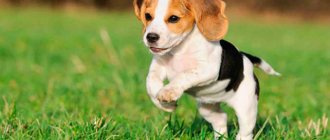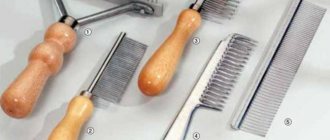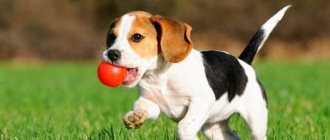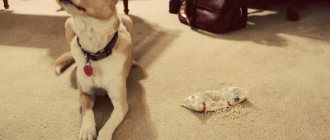Veterinarian tips for caring for dogs: keeping your pet indoors
Veterinarian tips for caring for dogs:
- When you get a dog, you must first determine where it will live, in the house or in the yard? It is necessary to arrange a good place for the dog in the house, taking into account its size. You need to choose a place where your animal can rest and watch what is happening around.
- Basically, such a place is chosen in the hallway so that the dog can perform a protective function - to protect a person’s house. There is no need to choose a place for it in the kitchen or in someone's bedroom; soon the dog will begin to climb on the table and move onto your bed or your child's bed.
- You should also not place your dog near heating appliances, as this will negatively affect the animal’s fur and body temperature. Once you have chosen the ideal place to place your dog, you need to arrange it.
- For large dogs, a mattress is laid out, and if the dog is miniature, then it is equipped with a basket or a lounger. If the dog is a dwarf breed and you do not walk it outside, then you need to organize a place for the toilet.
- You need to put a special plastic tray and fill it with filler designed to absorb odor. All this is sold in pet stores. A dog that lives in a house also needs a place where it will eat.
- It should be in the kitchen and not have any obstacles so that the dog can freely go and eat. You need to put two deep bowls, made of high-quality material, preferably metal. They wash well and do not absorb the smell of food. One bowl for food, the other bowl for water.
A responsible owner means a healthy dog.
Instructions for Beginners
Beginning owners of furry happiness should take care of preparing their home for receiving a dog in advance. Even before the puppy arrives, it is important to acquire:
- bed;
- bowls for feeding and drinking, as well as one bowl for long walks and hikes;
- means of personal hyena;
- leash, harness and collar;
- a basic first aid kit (the veterinarian will help you assemble it);
- toys.
You should choose a secluded place for the dog in the apartment.
But it should not be located in an empty room so that the puppy does not become lonely. It is optimal to get a soft kennel - the puppy will be comfortable there. Toys should be placed close to the bed, in free access. In the absence of the owner, dogs not only sleep, but also try to have fun. If the puppy cannot get to his favorite ball, he will chew on something more accessible. It is important to know! After the puppy arrives in the apartment, you should remove all objects that it can chew.
After the dog is brought into the apartment, it is important to give him time to get comfortable. No need to carry it from room to room. This is now his territory and soon he will definitely explore every corner of it. The baby must know where his place is, where he can eat and relieve himself. If the puppy is very small, all this should be in almost one place at first.
Setting up a place for a puppy
Veterinarian tips for caring for dogs: keeping your pet outdoors
Veterinarian tips for caring for dogs:
- If the dog will live in the yard, then you need to create all the necessary conditions for it. First you need to determine what material the booth will be built from, where to install it and what size it should be.
- Basically, wood is chosen for the construction of a booth; it is the most heat-insulating material. You need to take good care of the booth, treat the cracks in it so that various parasites, such as fleas or ticks, do not appear there.
- You need to build a booth in accordance with the size of the dog, so he can warm it with his breath during the cold season. The booth is usually installed in a quiet place under a tree with dense foliage, so that in hot weather it shelters the dog from the scorching sun, and in winter from the cold wind. The entrance is made from the windless side.
- By winter, a caring owner should insulate the booth for his pet. They mainly insulate with polystyrene foam and cover it with a sheet of plywood so that the dog does not chew the foam. Veterinarians advise not to place the kennel directly on the ground, but to place it on bricks and lay straw there for the winter, so the floor in the kennel will not freeze.
- If you do everything correctly, then even in severe frost there will be a positive temperature in your dog’s kennel. If you don't want your dog to live on a leash, you can fence off an area for him.
Why should you clean up after your pet?
It is necessary to clean up after your dog for reasons of basic hygiene and considerations of cleanliness of the yard, city, and country. We are faced with a well-known phenomenon when the snow melts in the spring and the entire lawn near the house is literally littered with excrement. Not only is this state of affairs unethical, but a gross violation of sanitary and epidemiological standards should be taken into account. Such feces can (and often are) a source of spread of helminths and other diseases. Not only do the pets themselves suffer, but the health of the people living there is also at risk. In addition, feces can damage the property of citizens and cause moral damage, which will lead to problems for the owner. Important! Cleaning up after your dog in the city is part of proper care!
Veterinarian tips for caring for dogs: feeding your pet
Veterinarian tips for caring for dogs:
- You need to feed your dog 2 times a day.
- Veterinarians advise feeding dogs proper and natural nutrition.
- There is no need to feed your dog what you eat yourself: salty, fried, sweet, fatty, sausage, cheese, pork.
- Your pet's diet should consist of lean meat, vegetables, dairy products and cereals.
- Veterinarians advise not to feed dogs flour, as this disrupts the animal’s intestinal microflora.
- Beef is the most favorite and healthy meat for four-legged friends, as well as horse meat and rabbit meat.
- Chicken and turkey meat should be given with caution, while monitoring the reaction on the skin.
- The meat must be given raw at least every other day, after scalding it with boiling water. With raw meat, the dog, as a carnivorous animal, receives the necessary phytonutrients necessary for the normal metabolic processes of its body. Without raw meat, your dog will likely become sick and may experience hair loss.
- You can also feed your dog dry food, which is now sold in any store.
- You need to buy not the cheapest one, as it has a bad effect on the dog’s health, but a premium one. You can’t mix dry food and regular food; it’s better to feed them separately, either one or the other.
- Don't overfeed your dog. A fat dog is a sick dog. Ask your veterinarian about food intake for your breed of dog.
- Fermented milk products need to be chosen at such a fat content that the dog does not have a weakened stomach. Veterinarians advise using such products in food with no more fat than 9%.
- You can eat almost anything from vegetables except cucumbers and cabbage. It is better to give vegetables either with meat or separately from everything else, but in no case with fermented milk products. Before feeding your pet vegetables, you need to chop them. Greens are also good for animals.
- A dog needs vegetables, both boiled and raw. If your dog doesn't eat raw grated vegetables, mix them a little into his favorite food.
- You can add chicken and quail eggs to dairy foods, but no more than three times a week. If the dog is healthy and feels good, then it does not need vitamins. Veterinarians recommend vitamins for puppies and pregnant dogs.
Dog walking rules and physical activity
The rules for keeping dogs of any breed are regular walks. It is necessary to take the dog outside at least 2 times a day, in the morning and evening hours.
For small dogs, 5-10 minute walks will be enough to feel comfortable.
Representatives of larger breeds will require longer stays outside and greater physical activity.
The average duration of walks should be about 2 hours a day.
It is advisable to equip a play area in the house for your pet and devote some time every day to communicate with him and have fun together.
Physical activity is very important for a dog’s health, strengthening its immunity, cardiovascular system, and increasing vitality.
Veterinarian Tips for Caring for Dogs: Pet Accessories
Veterinarian tips for caring for dogs:
- Veterinarians advise owners of four-legged friends to buy a collar, muzzle, toys, leashes, comb or brush. These are the most necessary accessories for pets.
- The collar is put on the dog in the neck area and a leash is attached to it. The collar is fastened according to the size of the dog’s neck; it should not be too tight or too loose. An address tag is also attached to the collar; this is a pendant with the coordinates of the animal’s owner, so that in case of loss, it can be returned to its owners.
- A muzzle provides protection to people from dog bites. It is also designed to protect your pet from junk food that he might pick up on the street.
- Leashes can now be purchased from various materials and different lengths. They are necessary for walking dogs on the street. Roulette leashes have become popular now; they are adjustable in length.
- Toys are also made from various materials, the safest material is latex; if a dog swallows it, it will simply be digested.
- Combs and brushes are essential for grooming dogs' fur. We'll talk about this below.
Accessories are an integral part of animal care.
Rules for walking on dog parks
The legislation provides for the organization of separate areas for walking pets. For example, walking without a muzzle and a leash is allowed on areas that are marked with a special warning sign.
The following requirements apply to the walking area:
- area of at least 400 sq. m;
- the height of the fence to enclose the territory is at least 2 meters;
- the distance to children's and educational institutions is at least 40 meters;
- residential and commercial buildings must be located at least 25 meters away.
In addition, the coverage of the territory must be updated annually, and dog boxes must be installed within the site. The condition of the dog walking area is monitored by the local government.
You may also find the rules for walking dogs during a pandemic and self-isolation helpful.
Veterinarian tips for caring for dogs: washing your pet
Experts advise taking the first bath seriously, because further bathing will depend on how it goes. If the first bath goes well, then the dog will be delighted in the future, but if the first bath goes wrong, the dog will resist.
Veterinarian tips for caring for dogs:
- Praise your pet to make him feel positive.
- It is better not to comb dirty fur, as you can damage the hair structure.
- There is no need to bathe your dog very often; it is better to do it as soon as it gets dirty. Of course, this procedure is done more often in the summer, because the dog quickly gets dirty, and less often in the winter. It is better to wash your paws every time after a walk. Veterinarians recommend washing your dog 1-2 times a month and only with a special shampoo, since the pH of dogs’ skin is different from the pH of human skin.
- They bathe dogs in the bathtub, but there is no need to take a full bath; only the animal’s paws should be in the water.
- Make sure that water does not get into the animal's ears. To be on the safe side, it is better to plug your ears with cotton wool.
- Bath procedures are best carried out in the evening or during the day, then it is not recommended to go outside for 4 hours after bathing, so that the dog does not get sick.
- After bathing, veterinarians advise applying a special product to the dog’s fur to prevent tangles. If they cannot be avoided and they cannot be combed out, then they need to be cut off with scissors.
- After bathing, let your dog shake his coat to get rid of excess water, then gently pat it down with a towel. Do not make sudden movements, as you may harm the animal.
- You should only wash your pet with dog shampoos. They can be diluted if the dog is not very dirty, this way you can use it sparingly, it will not lose its properties. Many owners buy bath products with lanolin, this is a special oil that is added to shampoo to protect and shine the coat.
Praise your dog more often to evoke positive emotions in him.
Basic Rules
Before getting a pet, it is very important to evaluate your own strengths and readiness to properly care for the dog. A four-legged friend is a real member of the family, he is also sick, needs care and love, so you need to get him only when it is possible to give him due attention.
Learning to care for a puppy or adult dog is not difficult. It is important to provide them with proper feeding, promptly examine the animal’s fur, eyes and ears for rashes, pathological discharge, and, if necessary, show it to a specialist.
Communication with your four-legged friend is important: only with patience can you overcome this barrier. After all, the dog does not always understand the first time what it needs to do. This is the task of the dog owner - to train and establish good contact with the animal without the use of shouting and physical violence. Let's take a closer look at all the nuances of keeping a dog.
Veterinarian Tips for Grooming Dogs: Grooming
Start brushing your pet from an early age, so he will quickly get used to this daily procedure. A dog's coat not only protects it during the cold season, but it can also be used to monitor your pet's health. An experienced veterinarian can determine the animal’s age, various diseases, and the environment in which the pet lives by the condition of its coat. In order for the dog to be not only beautiful, but also healthy, a loving owner takes very careful care of the fur of his four-legged friend.
Veterinarian tips for caring for dogs:
- Nutrition. What kind of fur an animal has directly depends on its nutrition. To keep the coat healthy, the food must be of good quality. With the food she eats, she should receive all the necessary minerals and vitamins.
- Health . If a dog has any health problems, this will immediately affect the condition of its coat. A healthy dog's coat is shiny and odorless, but a dog that has health problems has hair that begins to fall out, dandruff appears, and becomes dull.
To comb, you need to purchase quality tools. For dogs with short hair, only a comb is suitable, but for a long-haired pet you need more tools: a comb with long teeth, a tangle cutter, a slicker brush. It is recommended to start combing long hair from the ends, so you will not damage it.
A well-groomed coat is the beauty and health of an animal.
Veterinary examination
If you follow the rules of caring for pets, you cannot limit yourself only to the course of mandatory vaccinations and emergency trips to veterinary clinics. To monitor your pet's health, regular visits to the veterinarian are necessary.
Preventive examinations by a veterinarian, which should be carried out systematically, will help avoid serious illnesses and spending extra money on treating your pet.
Experts recommend visiting veterinary clinics at least twice a year: the first during routine vaccination, the second six months after that.
During a medical examination, additional examination of the animal may be necessary in order to recognize possible pathologies, hidden abnormalities, and exacerbations of chronic diseases. When the diagnosis is confirmed, the schedule for visiting the doctor is drawn up individually, based on the general state of health, age indicators, and the breed of the dog.
Remember: in order to promptly recognize any health problems in your pet, you must first give it a sufficient portion of your attention and respond to any changes in behavior.
If your pet has lost his appetite, he began to behave unusually passively (apathy), sleep more, move less, you should show him to a doctor in the near future.
Veterinarian advice on caring for dogs: diseases, their symptoms
A dog is susceptible to various diseases, and it doesn’t matter if it’s a domestic dog or a mongrel. If an animal gets sick, there is a high risk for humans to become infected from it. Let's look at the diseases that dogs can get.
Viral diseases. These include: herpes, rabies, otitis media, pneumonia. Symptoms that can be used to determine that a dog has a viral disease are as follows:
- runny nose;
- loss of appetite;
- sneezing;
- hard breath;
- lethargy;
- elevated temperature.
Skin diseases. These include dermatitis, scabies and lichen. The symptoms of such diseases are as follows:
- redness on the skin:
- itching;
- hair loss.
Oncological diseases. This disease affects not only people, but also animals. Symptoms of this disease include:
- loss of appetite;
- the animal has suddenly lost weight;
- poor coat condition;
- dull, painful look;
- severe weakness;
- With kidney cancer, blood is found in the urine.
Ear diseases. They can be allergic, viral, bacterial, caused by injuries, and can also occur if the dog has parasites. Symptoms:
- plaque of unnatural color;
- itching;
- redness and swelling of the ears;
- squealing when the ear is touched.
Eye diseases can be infectious, non-infectious, senile, or congenital. Common signs of the disease include:
- itching;
- redness;
- purulent discharge;
- swelling of the eyes;
- cataract;
- profuse lacrimation.
Worms. This disease includes opisthorchiasis, taeniasis and others. The symptoms of these invasions are as follows:
- lethargy:
- weight loss;
- bloating;
- intestinal disorders;
- deterioration of coat condition;
- changes in appetite.
A properly raised dog lives a long time - this must be remembered.
If you notice that your dog feels unwell, behaves strangely and begins to look worse, do not self-medicate, contact your veterinarian immediately. He analyzes the dog’s condition, prescribes the correct treatment, and makes a diagnosis. If you wait too long, you can harm your health, and the dog can end in death.
Taking care of your health
It is the direct responsibility of every dog owner to take care of its health. That is why he must know the main signs of the disease:
- temperature increase;
- loss of appetite;
- thirst;
- dry and hot skin;
- rapid breathing;
- rapid heartbeat;
- impaired digestion.
Every dog breeder can measure a dog’s temperature and pulse. The first indicator ranges from 38.8-39 degrees, measured rectally. It is necessary to take into account the fact that during physical activity, due to the absence of sweat glands in the dog, the body temperature rises briefly. This is fine. The second indicator, depending on the breed, is 70-120 beats per minute. We count the beats for 15 seconds, then multiply the number by 4.
Vaccination
Vaccinations can provide reliable protection against many diseases. There is no need to do them yourself, and a veterinarian will do an excellent job with this task. Before vaccination, you need to make sure that the dog is healthy and free of worms and parasites. The procedure is carried out annually, and the first vaccination is given to the puppy at the age of one month. Although some dog breeders advise vaccinations only 3-4 months after birth, when the puppies’ immunity is already stronger.
Once a quarter, the dog is given anthelmintic drugs and treated with anti-flea compounds. In early spring and before snow falls, the animal's fur is periodically treated with anti-tick drops.
Do I need to castrate or sterilize?
Castration is a procedure for removing the sex glands that produce hormones and contribute to reproductive function. Sterilization involves tying the fallopian tubes in females and the seminal ducts in males. The operation is more complex, and sterilized individuals continue to produce hormones, although they are not able to reproduce.
Neutered dogs' behavior changes; they are not as aggressive as their non-operated relatives during the period of searching for a sexual partner. There are no other negative manifestations, they do not lose their protective qualities, their character and habits do not change either. The dog lived for a long time in a pack, where reproduction functions belonged only to individual individuals, so the psycho-emotional and physical condition of the pet does not suffer after the operation. Unneutered dogs are more stressed if their natural physiological needs are not met. In addition, they are more likely to suffer from various traumatic ailments, tumors and sexually transmitted diseases. Life expectancy under the influence of various stresses also decreases.
Sterilization of a domestic dog can solve many problems associated with placing offspring in good hands. Many people decide to drown puppies or abandon them to their fate - this is inhumane and extremely harmful to society.











